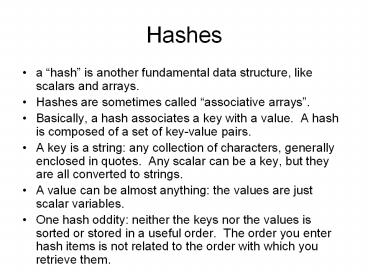Hashes - PowerPoint PPT Presentation
1 / 7
Title:
Hashes
Description:
A hash is composed of a set of key-value pairs. ... Examples of hash usage: ... For example, the hash %stoplight is populated as follows: $stoplight{red} = 'stop' ... – PowerPoint PPT presentation
Number of Views:37
Avg rating:3.0/5.0
Title: Hashes
1
Hashes
- a hash is another fundamental data structure,
like scalars and arrays. - Hashes are sometimes called associative arrays.
- Basically, a hash associates a key with a value.
A hash is composed of a set of key-value pairs. - A key is a string any collection of characters,
generally enclosed in quotes. Any scalar can be
a key, but they are all converted to strings. - A value can be almost anything the values are
just scalar variables. - One hash oddity neither the keys nor the values
is sorted or stored in a useful order. The order
you enter hash items is not related to the order
with which you retrieve them.
2
Why Use Hashes?
- The C language doesnt have anything like a hash
in it, and clearly C can do just about anything
you need to do in programming. - The point of Perl is to make your life easier, to
include useful tools, even if they are messy and
clutter up the language. - Examples of hash usage
- --keeping count of the number of times a
word is used in a text, or that a particular
sub-sequence appears in DNA. Use the word as the
key and the number of appearances as the value. - --Associating ID numbers with peoples names
- --Associating protein names with their
properties. - And lots more. The hash is a tool that gets used
very frequently once you understand them.
3
Hash Basics
- The punctuation mark used to denote a hash is
(percent sign). - Note that hashes, arrays, and scalars are
completely different variables. The variables
cat, _at_cat, and cat are all different and
independent variables. I dont recommend using
the same names for different variables, but it is
legal. - Hash elements are accessed by enclosing the key
in curly braces. For example, the hash
stoplight is populated as follows - stoplightred stop
- stoplightyellow caution
- stoplightgreen go
- In this hash, red, yellow, and green
are the keys, and stop, caution, and go are
the values. - Each key can refer to only a single value. You
cant have duplicate keys. If you try, the first
value will be lost and only the second will work - stoplightyellow speed up
- print stoplightyellow\n
- prints go faster
- However, different keys can refer to the same
value without any problem.
4
Alternative Way of Loading Hashes
- A hash really is an array with alternating keys
and values. You could load a hash by simply
writing the keys and values the same way as you
would load an array - stoplight (red, stop, yellow,
caution, green, go) - This method is a bit annoying, because it is easy
to lose track of keys and values. A better way
is to use the gt operator (big arrow), which is
really just a synonym for a comma - stoplight ( red gt stop,
- yellow gt
caution, - green gt go )
- Note the use of newlines here--makes reading
the code easier.
5
Hash Operators
- keys gives a list of all the keys used in the
hash. Heres a common use - foreach key (keys stoplight)
- print key stands for
stoplightkey\n - Note that the keys are not returned in a useful
order. If you want them sorted you could write - foreach (sort keys stoplight)
- or
- foreach (sort a ltgt b keys
stoplight) - Similarly, values gives a list of all the
values, in some unusual order. - each is an operator that returns a 2 element
list consisting of the key and the value. It
needs to do this in tandem with while - while ( (key, value) each stoplight)
- print key value\n
6
More Hash Operators
- Removing elements in a hash is done with
delete - delete stoplightred
- both key and value are removed
- Testing for existence with exists
- exists stoplightred) returns true if
that key-value pair exists, and false if it
doesnt.
7
Counting
- Heres a simple use of hashes to get word counts.
Input is a file of words, one per line. - while (word ltSTDINgt)
- chomp word
- word_hashword
- Note that word_hash was created implicitly,
without ever being explicitly declared. This is
a standard Perl feature, but I will shortly
discourage its use. - Also, a nice feature of using hashes for counting
is that each value is automatically set to 1 the
first time a new key is encountered. That is,
you dont have to initialize each key-value pair
Perl does it for you automatically.































